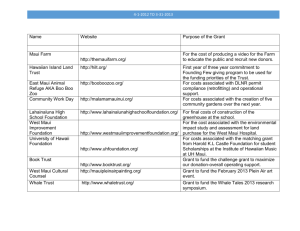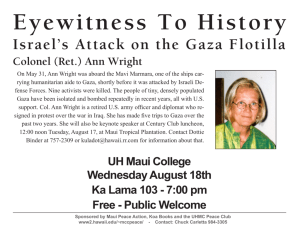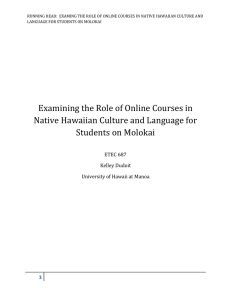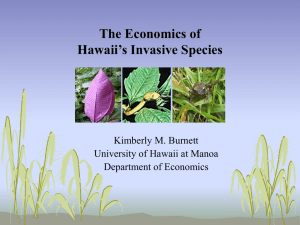Document 11242408
advertisement
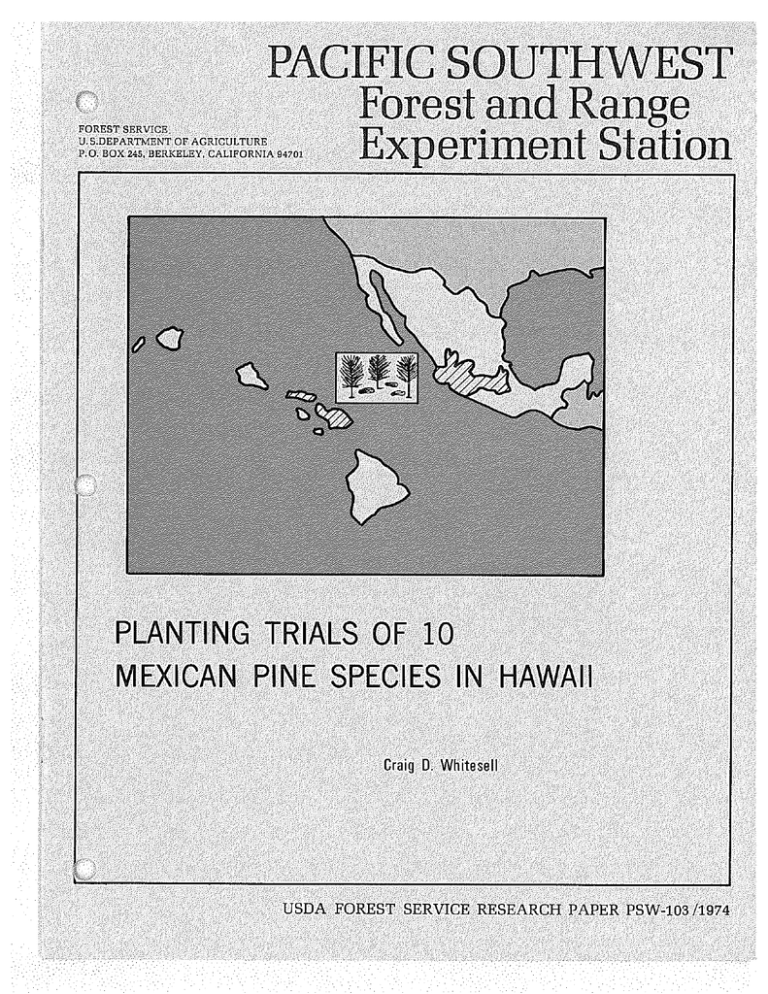
CONTENTS Page Summary .............................................. 1 Introduction ........................................... 3 Methods .............................................. 3 Nursery Transplanting .................................. 3 Planting Design ....................................... 4 Planting Sites ......................................... 4 Observations and Measurements .......................... 6 Results and Discussion ................................... 6 Survival ............................................. 6 Growth ............................................. 6 Vigor ............................................... 7 Stem Form .......................................... 7 Insects and Disease .................................... 7 Conclusions ............................................ 8 Literature Cited ......................................... 8 The Author CRAIG D. WHITESELL is assigned to the Station's Institute of Pacific Islands Forestry, headquartered in Honolulu, Hawaii. He is doing research on the silviculture of native and planted forests in Hawaii and Guam. He received his bachelor's degree (1951) from West Virginia University, and his master's degree (1954) from Duke University-both in forestry. He has been with the Station's Hawaii staff since 1962. ACKNOWLEDGMENTS I thank Dr. Bruce Zobel and Dr. L. C. Saylor, School of Forest Resources, North Carolina State University, for their cooperation on this study, and other members of the North Carolina State UniversityIndustry Cooperative Tree Improvement Program for providing seeds and source data from Mexico. U.S. Forest Service research in Hawaii is conducted in cooperation with Division of Forestry Hawaii Department of Land and Natural Resources SUMMARY Whitesell, Craig D. 1974. Planting trials of 10 Mexican pine species in Hawaii. USDA Forest Serv. Res. Paper PSW-103, 8 p. Pacific Southwest Forest and Range Exp. Stn., Berkeley, Calif. Oxford: 174.7 Pinus spp.-(72):(969):232.11 Retrie~lalTerms: Pinus spp., Mexican pines; species trials; mortality; life form; Hawaii Because Hawaii has no native conifers, tree planters began introducing species of the Pinus genus to the islands. These introductions were started in the 1890's. Not until the 1960's did foresters include pines from Mexico. Rich in Pinus species, Mexico resembles Hawaii in latitude, elevation, rainfall, and soils. In 1962, pine seeds were made available to the U.S. Forest Service for planting trials in Hawaii. The seeds had been collected by the North Carolina State University-Indust~y Tree lmprovement Program in central Mexico. The seeds were planted on two islands: 10 species representing 70 families were outplanted on Maui; five species, representing 28 families, were outplanted in Molokai. A family refers to all seedlings propagated from seeds collected from one soecific mother tree growing in Mexico. The planting site on Maui is on the leeward slope of Mt. Haleakala, a dormant volcano, at 6450 feet (1970 m) elevation. The Molokai site is on a narrow upland ridge at 3200 feet (975 m) elevation. Annual rainfall averages 40 inches (1000 mm) or more at both locations, but this amount varies greatly from year t o year. The experimental plantings were laid out in a randomized block design, with four replications and 15-tree row plots. Each row plot consists of the progeny of one mother tree. Survival, growth measurements, vigor, and stem form of the trees were recorded at the end of the first, third, and fifth years after outplanting. Nine species planted on Maui and five species on Molokai showed promise at age 5. Average annual height growth ranged from 1 to 3 feet (0.3 to 1 m) on Maui and from 1 t o 2 feet (0.3 to 0.6 m) on Molokai. Average height growth varied greatly among families within species, and this was also true for survival. Average diameters at breast height at age 5 ranged from 1.7 to 2.7 inches (4 to 7 cm) for all species with 10 or more measurable trees except Pinus michoacarza var. comuta On Molokai, this variety averaged 3.7 inches (9 cm) d.b.h. Low initial survival was primalily related to poor planting stock and adverse site conditions. Less than 5 percent of any one species died during the last 2 years. Most of the surviving trees on both islands were vigorous, healthy plants 5 years after outplanting. P. oocarpa, planted on Maui, was an exception; twothirds of the trees showed poor vigor and had dieback that was related t o frost damage. Strong winds caused broken stems, windthrow, or damaged leaders, chiefly in P. leiophylla on both islands, and in P. patula on Maui. Wild pigs partially or completely girdled some of the largest trees on Molokai. They were particularly attracted toP. montezumae and P. pseudostrobus. The only serious insect infestations occurred on Maui, where two species of aphids attacked all 10 species planted. No diseases were observed on any of the pines. The success of most of the species in these trials is attributed to the similarities in latitude, elevation, and rainfall between the collection areas in Mexico and the planting sites in Hawaii. Species that are growing well on both Maui and Molokai are P. montezumae, P. michoacana var. comuta, P. pseudostrobus, P. tenuifolia, andP. leiophylla Potentially useful species planted only on Maui are P. harhvegii, P. michoacana, P. rudis, P. patula, and P. teocote. These species can be used to meet the need for erosion control, amenity plantings, and recreation forests where conifer species are desired. T o make up for the lack of native conifers, tree planters in Hawaii began introducing species of the Pinus genus in the early 1890's (Bryan 1947). Not until the 1960's, however, did they begin to try out the Mexican pines-even though Mexico and Hawaii have highly similar climates, and Mexico is perhaps the "richest pine-growing region in terms of number of species" (Din 1958). A wide variety of pine species grow in Mexico at Hawaii's latitude (19' to 22' N.), some on soils of volcanic origin, and under temperatures and rainfall conditions similar to those found in the State. These Mexican species can grow under a broad range of site conditions. Several have been successfully introduced in Africa (Kriek 1970; Loock 1950; Mirov 1967), Australia, and elsewhere (Streets 1962). One reason why Mexican pines have only recently been tried in Hawaii has been the difficulty in obtain- ing seeds from Mexico-and that difficulty still persists. It was partially overcome in 1962 when cooperators in the North Carolina State University-lndustry Tree Improvement Program collected pine seeds in Mexico (Saylor and McElwee 1963; Zobel 1970). Their primary goal was to collect seeds of species that offered promise for commercial use on adverse sites in the Southern United States and elsewhere, where native species do not grow satisfactorily or where pines are not indigenous. They distributed seeds to cooperators throughout the Southeastern United States, Hawaii, and Brazil. Saylor (1969) reported third-year results of the planting trials. This paper reports results of planting trials of 10 Mexican pine species on the islands of Maui and Molokai, Hawaii, and suggests their implications for reforestation work in the State. METHODS Seeds of 10 species, one variety, and one form were obtained from 23 locations in five states in Mexico: Jalisco, Mexico, Michoacan, Puebla, and Tlaxcala (table I). They are situated between 19O and 20' North latitude and between 98O and 105' West longitude. The parent trees were generally growing in open stands. The seed collectors tried to obtain the best phenotypes, but this was not always possibleprimarily because pine seed yield was poor in 1962. Many stands were cut over, burned over, or grazed, and were understocked. Stands of Pinus montezumae and P. pantla of superior form and height were located, however, and seeds collected (Saylor and McElwee 1963). The collection sites ranged from 4520 to 12,000 feet (1380 t o 3600 m), elevation. Soils varied in fertility from low to high, and soil textures included volcanic ash, ash over silt loams, loams, sands, silts, and clays. Nursery Transplanting The seeds were sown at a State tree nursery on the island of Hawaii in 1963. Germination success ranged from poor to good for the 100 seed lots sown. Rodents, birds, flooded seed beds, and damping off contributed to mortality, reducing the number of seedling lots available for outplanting to 70. The seedlings were scheduled for outplanting during the rainy season (winter) of 1963-64. But the sites were too dry to plant that season because no winter stonns occurred. And so the seedlings were transplanted in the nursery. Many seedlings died thereafter. The surviving seedlings were lifted for shipment as 1-1 stock. Most had poor root systems. The quality and vigor of the seedlings were low. Therefore, the number available for many seed lots was fewer than that specified as desirable in the experimental design. Planting Design Planting Sites The experimental design prescribed for all participants in the North Carolina State University-Industry Tree Improvement Program was followed in Hawaii wherever possible. This randomized block design had four replications and 15-tree row plots. Initial spacing was 9 feet within and between rows. The number of plots for a given species in a block varied from 1 to 13. The seedlings in each plot represent a specific mother tree from which seeds were collected. AU seedlings from one mother tree are collectively referred to as a family. In Hawaii, lack of planting material reduced the number of blocks to either two or three for some seed lots. Ten species, represented by 70 families, were planted on Maui; because of the scarcity of material, only five species and 28 families were planted on Molokai (mble 2). The planting site on Maui is on the Kula Forest Reserve, 6450 feet (1970 m) elevation, latitude 20' 42' North, and longitude 156' 19' West. The site is on the leeward slope of Mt. Haleakala, a dormant volcano. Rainfall averages 40 inches (1000 mm) annually but varies greatly from year to year. Major storms occur most frequently between October and March; the rest of the year may be extremely dry. The estimated average annual temperature at the site, near Poli-poli Springs, is 53' F (12' C). Frosts occur occasionally during winter. Strong winds are a hazard to planted stands. Dense cloud cover or fog is almost a daily occurrence. The soil is Laumaia loam, a member of the medial, isomesic family of Q p i c Dystrandepts (formerly classified as a Latosolic Brown Forest soil). It is a welldrained soil developed from volcanic ash and cinders, Table l-Sources o f pine seed from Mexico outplanted on Moui andMolokai, Hamii Pinus species State and numbers of collections Elevation (meters) Latitude (N.) Longitude (W.) P. lrartwegii Lindl. Mexico (1) 3660 1g006' P. michoacana Martinez Michaacan (1) 1380 19'25' P. michoacano var. cornutn Martinez Michoacan (3) Jalisco (1) 1800-2320 19~2.5'to 20' P. montezumae Lamb. Puebla (2) Michoacan (1) Mexico (1) 2270-2710 19~10'to 19~30' P. montezumae forma Michoacan (I) 2100 ZOO P. rudis Endl. Tlaxcala (1) 2740 1g040' P. oocarpa Schiede Michoacan (2) 1450-1680 P. patula Schiede & Tlaxcala (1) Puehla (1) 2030-2680 19~40'to 20~12' 98'20' P. pseudosnobus Lindl. Puebla (1) Michaacan (1) 2040-2320 19~30' to 19~50' 97O to 102O P. tenuifolia Benth. Michoacan (1) 2100 19~30' 102O P. teocote Schiede & Tlaxcala (1) Puebla (11 2650-2830 19' P. leiopl~ylloSchiede & Michaacan (1) Puehla (1) 2100-2480 98O35' 101°50' 102' to 104' 98' to 102~50' 102~ macrocarpa Martinez Deppe Dew 19' to 19'20' 19°201to 19'30' 98'30' 102' to 104~20' to 98'30' 9'8 98'30' to 102' Table 2-Survival, height. vipor, rind form, at.age 5, o f Mexican pine species planted on Maui nndMolokai, Hawaii Location and Pinus species Survival Number Of Species average Family range -Percent- Hei&t Number Species Species Family of living average maximum Iange trees M e t e r s - Good vigor Good fonn -Percent- Maui: P. michoacana P. michoacana vat. cornuta P. montezumae P. montezumae f. macrocarpa P. oocarpa P. patula P. pseudosnobla P. tenuifolia P. teocote P. leiophylla Molokai: P. michoacana var. comuta P. montezumae P. pseudostrobus P. tenuifolia P. l@ioph~lm 1 and is 30 to 42 inches (76 to 107 cm) thick. The surface layer is mildly alkaline. The subsoil is either a clay loam or silty clay loam, and is neutral to medium acid (U.S. Soil Consem. Sew. 1972). Aspect is west, with slopes of 1 to 25 percent. Native vegetation consisted of grasses and scattered shrubs. The grass formed a tight sod over much of the area. The most common shrub present was pukiawe (Styphelia taemeiameiae [Cham.] F. Muell.) from 3 to 6 feet (1 to 2m) tall. A few sandalwood (Santalum spp.) and mamane (Sophora ch?ysophylla [Salisb.] Seem.) shrubs were also present. Site preparation consisted of clearing most of the shrub vegetation with a bulldozer, and scalping the sod at each planting spot with a mattock. The planting site at Molokai is on the Molokai Forest Reserve, 3200 feet (975 m) elevation, latitude 21" 09' North, and longitude 156" 56' West. The site is on a narrow upland ridge on east Molokai. Some rain usually falls each month, with the wettest period between November and April. The average is about 50 inches (1270 cm) annually, but sometimes from twice this amount to less than half may he recorded in any given year. The mean temperature averages 71' F (22' C), tlie mean temperature for February is 66' F (19' C), and for August, 75" F (24" C). The soil 1s Olelo sdty clay, a member of the clayey, oxidic, isothemic family of Humoxic Tropohumults (formerly classified as a Humic Fer~ginous Latosol). It is a well-drained sod, developed from basic igneous rocks weathered in place. The surface layer, a dark reddish-brown color, contains ironstone concretions. The subsoil is also a dark reddish-brown silty clay. This soil is strongly acid, the surface layer having a pH of 4.8 and the subsod a pH of 4.6 to 4.8 (U.S. Soil Conserv. Serv. 1972). Aspect is east, with slopes of from 3 to 25 percent. The native vegetation consisted chiefly of scrub ohia (Metrosideros collina [Forst.] Gray), 'a'ali'i (Dodoneae spp. Mdl.), H ~ l ograss (Paspalum conjugatum Berg.), and pukiawe. The site was prepared with a bulldozer, cleared either in strips one blade wide (12 feet or 3.5 m), or by creating larger openings with the scrub vegetation pushed into gullies or windrows. Observations and Measurements The age of trees was calculated from the date of outplanting, in 1965. Observations and measurements were recorded the first, third, and fifth succeedmg years. At the end of the fifth year after outplanting, I checked the seedlings for survival, total height, diameter, vigor, and stem form. Individuals severely damaged by frost or winds, which produced multiple stems, broken tops, and windthrow, were excluded in height and diameter computations. To be rated as having good form, a tree had to have a straight single stem, i.e., no sweep, crooks, or forks. Tree vigor was rated as either good (healthy in appearance) or poor (sickly). Stem diameters of all trees over 5 feet (1.5 m) tall were measured at breast height (d.b.h.). RESULTS AND DISCUSSION Survival died back nearly to the ground. A few seedlings were kiUed outright. Poor initial survival, though disappointing, was not unexpected, because of poor quality planting stock and harsh site conditions. Survival by the fifth year of the 10 species planted on Maui ranged from 11 percent for P. michoacana to 63 percent for P. hartwegii'. Among the five species planted on Molokai, it ranged from 13 percent forP. montezumae to 69 percent for P. tenuifolia (table 2). Most mortality occurred during the first year: in half of the species, less than one-third of the trees were stdl alive. Some sickly trees of each species (a maximum of 7 percent per species) died during the next 2 years. Subsequently, during the fourth and fifth years, no more than 4 percent of any one species died, and some of this loss was caused by severe winds. On Maui, half of the species had no mortality during this period, and mortality was nearly as low on Molokai. Within most species, considerable variation in survival occurred among families. Three species, P. patula, P. leiophylla, and chiefly l? oocarpa, suffered frost damage on Maui. Thirtyseven percent of the P. oocarpa were top-killed or Growth The average fifth-year heights ranged from 4.5 feet (1.4 m) for P. oocarpa to 14.4 feet (4.4 m) for P. tenuifolia, and 14.6 feet (4.5 m) for P. patula, on Maui (table 2). P. pseudostrobus averaged 13.3 feet (4.1 m) and P. montezume f. macrocarpa averaged 12.5 feet (3.8 m). The latter far exceeded its type (P. montezumae), which averaged 7.7 feet tall (2.3 m) during the 5-year period. P. karhvegii has been described by Loock (1950) as slow growing but of good form. Our seed source from the upper volcanic slopes of Mount Popocatepetl, Mexico, at 12,000 feet (3660 m), grew slowly on Maui, averaging 1 foot (0.3 m) a year, with good form. On Maui, differences in average total height growth of families within a species varied from 0 to 8 feet (2.4 m). At the lower-elevation Molokai site, P. montezum e was the slowest growing, averaging 5 feet (1.5 m) in 5 years (table 2). The two fastest growing species, P. pseudostrobus and its close relative P. tenuifolia, each averaged slightly more than 11 feet (3.4 m). The ' somewhat poorer height growth of these two species on Molokai can be attributed to terminal dieback and forking among the tallest individuals more exposed to wind. This "mechanical" damage to the thin, tender shoots by wind is one of the several causes of forking in P. pseudostrobus that Loock (1950) observed in the Republic of South Africa. Differences in average height growth of families within a species ranged from 1 to 8 feet (0.3 to 2.4 m) on Molokai. Where 10 or more trees of a species were measured, the average diameters were computed. These ranged from 1.7 to 2.7 inches (4 to 7 cm) with one exception: On Molokai, 33 P. michoacana var. cornuta trees averaged 3.7 inches in diameter (9 cm), and one individual measured 6.1 inches (15 cm) d.b.h. Vigor ( Most of the trees were robust, healthy plants 5 years after outplanting. Nine species on Maui had at least 93 percent of the trees showing good vigor (table 2). Eighty-seven percent of the P. leiophylla and 85 percent of the P. patula trees showed good vigor, whereas only 34 percent of the P. oocarpa were rated as vigorous. On Molokai, the species with the highest percentage of vigorous trees was P. michoacana var. comuta (100 percent); the lowest was i? montezumae (90 percent) (table 2). Stem Form Strong winds at both the Maui and Molokai sites damaged trees of some species more than those of others. On Maui the percentage of trees which were not measured because of severe wind damage (broken stems or windthrow) ranged from 0 to 4 percent for eight species. This loss increased to 7 percent for P. leiophylla and to 9 percent for P. patula. On Molokai, wind damage was less than 2 percent for each of four species, ahd was 7 percent forl? leiopkylla. Few species had a high percentage of straight, single-stem trees. Only about two-thirds of the trees on Maui and less than half of those on Molokai had single, straigl~tstems (table 2). The species with the lowest percentage of straight unforked stems were P. oocarpa (24 percent) on Maui and P. leiophylla (14 percent) on Molokai. Although local environmental factors accounted for poor form to some extent, genetic factors also played an important role. Examination of the seed collection data determined that most of the stems of the parent trees in Mexico were graded as fair or poor; that is, most had some crook or twist. Many of the stands bad been cut over. Differences between sources are illustrated by the performance of two collections of P. leiophylla, one in Michoacan at 6900 feet (2100 m) elevation and the other in Pueblo at 8130 feet (2480 m) elevation. On Maui, the Pueblo source had 76 percent (of 102 trees) with straight single stems, compared with 22 percent (of 143 trees) for the Michoacan source. Loock (1950) reported: "In Michoacan .. . two distinct strains appear to exist. The one is usually very branchy, of poor form and rather short and crooked boled, while the other has a fairly good form and often reaches heights of up to 8 0 feet." The Michoacan source for the present study could be a representative of the branchy, poor form strain. The families of three species, P. patula, P. montezumae, and P. michoacana var. cornuta, were also grouped by provenance, but no significant variation in form was found within these species. A few individuals of three species developed "foxtailsn-elongated stem growth with no lateral branches. This type of growth is common when pines are grown in the subtropics or tropics (Kozlowski and Greathouse 1970). Two percent of the P. montezumae, P. pseudostrobus, and P. leiophylla stems on Maui and the P. pseudosnobus on Molokai had this characteristic. On Molokai, wild pigs seemed particularly attracted to P. montezumae and P. pseudostrobus, either partly or completely girdling the stems. They usually selected the best trees. The pigs completely ignored only one species,P. michoacana var. cornuta. Insects and Disease The only serious insect infestations occurred on Maui, where two species of aphids were observed on all of the pines tested except P. michoacana var. cornuta The two aphids were identified by the State Entomologist as Cinara carolina Tissot and Macrosiphum avenue (Fabricius). Eventually, they were controlled by the ladybug beetle (Hippodamia convergens [Guerin-MendviIleJ). No diseases were observed on any of the pines. CONCLUSIONS Early indications. are that Mexico deserves increased attention as a source of conifer species for reforestation on adverse sites at higher elevations in Hawaii. The success of the planting trial can be attributed to the similarities in latitude, elevation, and rainfall between the seed sources in Mexico and the sites in Hawaii. Considering the site conditions, growth and vigor of these Mexican pines must be rated as excellent. Species that have performed well on both Maui and Molokai are Pinus montezumae, P. michoacana var. cornuta, P. pseudostrobus, P. tenuifoiia, and P. ieiophyiia. Potentially useful species planted only on Maui are P. hartwegii, P. michoacona, P. mdis, P. potuln, andP. teocote. These Mexican pine species can be used to meet several of the State Division of Forestry's management objectives: the development of multiple-use forests for recreation, erosion control, and amenity plantings (Sager and Korte 1971). Mexican pines could be used on these sites for replanting understocked hardwood plantations and for controlling noxious plants. More time is needed before the value of these species for timber production can be determined. LITERATURE CITED Bryan, L.W. 1947. Twenty-five years of forestry work on the island of Hawaii. Hawaii Planters' Rec. 51(1):1-80. Din, U Aung. 1958. Pines for tropical areas. Unasylva 12: 121-133. Kozlowski, T. T., and T. E. Greathouse. 1970. Shoot growth and form of pines in the tropics. Unasylva 24(4):6-14. Kriek, W. 1970. Performance of indigenous and exotic trees in species trials: Report t o the government of Uganda. Food & Agric. Organ. TA,2826,73 p. Loock, E. E. M. 1950. The pines of Mexico and British Honduras. Union . Bull. 35.. 244 D. S. Africa D ~ DFor. Mirov, N. T. aenus Pinus. 602 D. Ronald Press Co.. New 1967. The York. Sacer. - .William H., and Karl H. Korte. 1971. Management plan for Kula Forest Reserve, island of Maui, 52 p. Hawaii Dep. land and Natur. Resour., Honolulu, Hawaii. . Saylor, L. C. 1969. Provenance testing- Mexican pines in the U.S. and Brazil. Southern Forest Tree Improv. Comm. Sponsored Publ. 30:154-164. Saylor, L.C., and R. L. McElwee. 1963. Collecting pine material in Mexico for provenance trials and wood studies. Univ. N. Carolina at Raleigh, Tech. Rep. 18, 23 p. Streets, R. 1. 1962. Exotic forest trees in the British Commonwealth, 865 p. Clarendon Press, Oxford. U.S. Soil Conservation Service. 1972. Soil survey of the islands of Kauai, Oahu, Maui, Molokai, and Lanai, State of Hawaii, 232 p. Honolulu, Hawaii. Zobel, B. J. 1970. Mexican nines. In Genetic resources in plants. their exploration and conservation, 0. H. F~ankeland E. Bennet, eds., p. 375-379. Blackwell Scientific Publ., Oxford, England.
